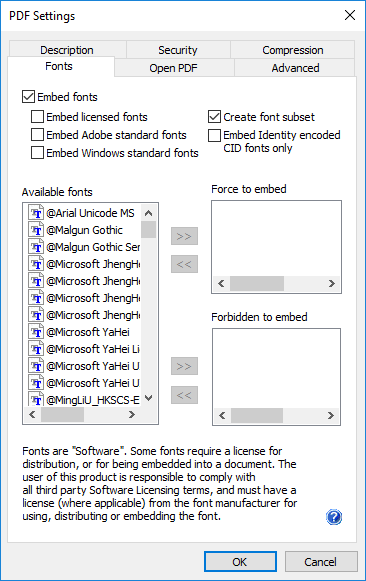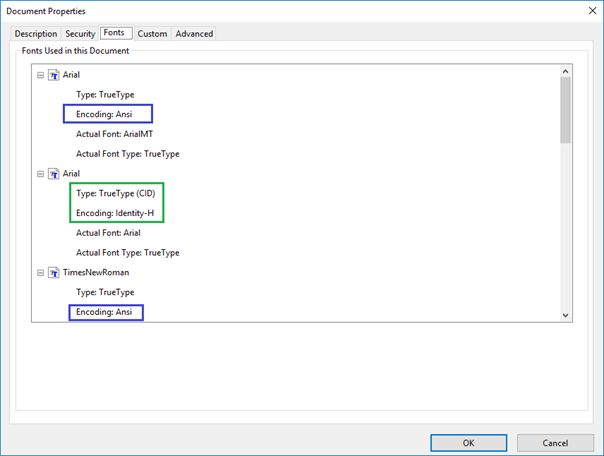

The PDF standard supports 14 default fonts: Times (4 types), Helvetica (4 types), Courier (4 types), Symbol and ZapfDingbats. If one uses only these default fonts when creating the PDF document, then most consumer PDF viewers will be able to display the document correctly. However if one creates a PDF file on a computer, which have certain non-default fonts installed, and they are used in the PDF document, the file might not display correctly on an other computer if that computer does not have those specific fonts installed.
The solution for this problem is to use embedded fonts. When a consumer application opens a PDF document containing embedded fonts, it can extract the fonts from the PDF file and use the extracted fonts to display the document correctly on any computer. The Black Ice’s PDF printer driver supports the following font formats for embedding: TrueType (.ttf), OpenType TrueType (.ttf), OpenType (.otf) and Type1 (.pfb, .pfm).
The embedded fonts increase the size of the document, but guarantee that the appearance of the text will be the same as in the source document in all consumer application on all computers. If the size of the font file is small, the font embedding is not a problem. However the size of Asian (Japanese, Chinese (traditional and simplified), Korean) font files are very big, embedding them might not be always practical. If the font will not be embedded the consumer application will try to display the text with the original font. If the original font is not installed it will be viewed with the viewer application’s own fonts.
In the PDF Settings window the embedded fonts can be specified under the Fonts tab.
Embed fonts: If this option is checked the printer driver embeds all the fonts in the PDF document except the licensed fonts, the 14 Adobe fonts, and the standard Windows fonts.
Embed licensed fonts: Certain font manufacturers may not permit the embedding of their fonts into a document without the proper licensing on the viewer’s machine. The small lock icon  before a font name indicates restricted license embedding. Fonts with “restricted license embedding” right will not be embedded into the document, unless the “Embed licensed fonts” checkbox is selected.
before a font name indicates restricted license embedding. Fonts with “restricted license embedding” right will not be embedded into the document, unless the “Embed licensed fonts” checkbox is selected.
Embed Adobe standard fonts: Standard Adobe fonts include 14 fonts which are carried with Adobe Acrobat Reader. Since most people view their pdf files with this program, the default setting is not to embed these fonts into the document to reduce the size of the output file. The following is the list of standard Adobe fonts:
· Courier
· Courier-Oblique
· Courier-Bold
· Courier-BoldOblique
· Helvetica
· Helvetica-Oblique
· Helvetica-Bold
· Helvetica-BoldOblique
· Times-Roman
· Times-Italic
· Times-Bold
· Times-BoldItalic
· Symbol
· ZapfDingbats
Embed Windows standard fonts: Standard windows fonts is a collection of fonts which are on almost every desktop windows machine. These fonts will not be embedded unless the embed standard windows font checkbox is selected. Here is a list of standard Windows fonts:
Arial
Arial Black
Arial Bold
Arial Bold Italic
Arial Italic
Comic Sans MS
Comic Sans MS Bold
Courier New
Courier New Bold
Courier New Bold Italic
Courier New Italic
Estrangelo Edessa
Franklin Gothic Medium
Franklin Gothic Medium Italic
Gautami
Georgia
Georgia Bold
Georgia Bold Italic
Georgia Italic
Latha
Lucida Console
Lucida Sans Unicode
Microsoft Sans Serif
Palatino Linotype
Palatino Linotype Bold
Palatino Linotype Bold Italic
Palatino Linotype Italic
Symbol
Tahoma
Tahoma Bold
Times New Roman
Times New Roman Bold
Times New Roman Bold Italic
Times New Roman Italic
Trebuchet MS
Trebuchet MS Bold
Trebuchet MS Bold Italic
Trebuchet MS Italic
Tunga
Verdana
Verdana Bold
Verdana Bold Italic
Verdana Italic
Webdings
Wingdings
MS Serif
MV Boli
Roman
Script
Small Fonts
Embed Identity encoded CID fonts only -Changes what type of font encoding is used in the generated PDF documents.
If the option is unchecked The Printer Driver embeds fonts with ANSI encoding, and if the document contains Unicode characters or glyph indexes, the Printer Driver will also embed “Identity” encoded CID fonts. (default)
If the option is checked The Printer Driver will only embed “Identity” encoded CID fonts. ANSI text is converted to a series of glyph indexes in the PDF. This option is useful when printing the PDF files with certain industrial printers that cannot handle multiple font objects that refer to the same physical font. Selecting this option may increase the size of the generated PDF documents.
Embedded fonts in Adobe with the Embed Identity encoded CID fonts only option unchecked:

There are Ansi and Identity encoded fonts embedded.
Embedded fonts in Adobe with the Embed Identity encoded CID fonts only option checked:

There are only Identity encoded fonts embedded.
Force to embed: These fonts will be embedded in the PDF document even if the embed fonts checkbox is not selected.
Forbidden to embed: These fonts won’t be embedded in the PDF document even if the Embed fonts checkbox is selected.
Create font subset: When embedding fonts it is possible to include only those characters in a font that were used in the document. This partial font is called a "Font Subset" If this option is checked fonts are embedded as font subset. This works only for TrueType/OpenType fonts. This setting can greatly reduce the output file size.
NOTE: In case if the “Embed Fonts” option on the PDF Settings tab is unchecked, some of the characters on the output documents became junk characters or dots. This is the normal behavior since the fonts used by the several applications (For example: Internet Explorer) are not system fonts, and they exist only temporarily for the time of the printing. To be able to display these fonts properly when opening the PDF document, the “Embed Fonts” option must be enabled during the printing.